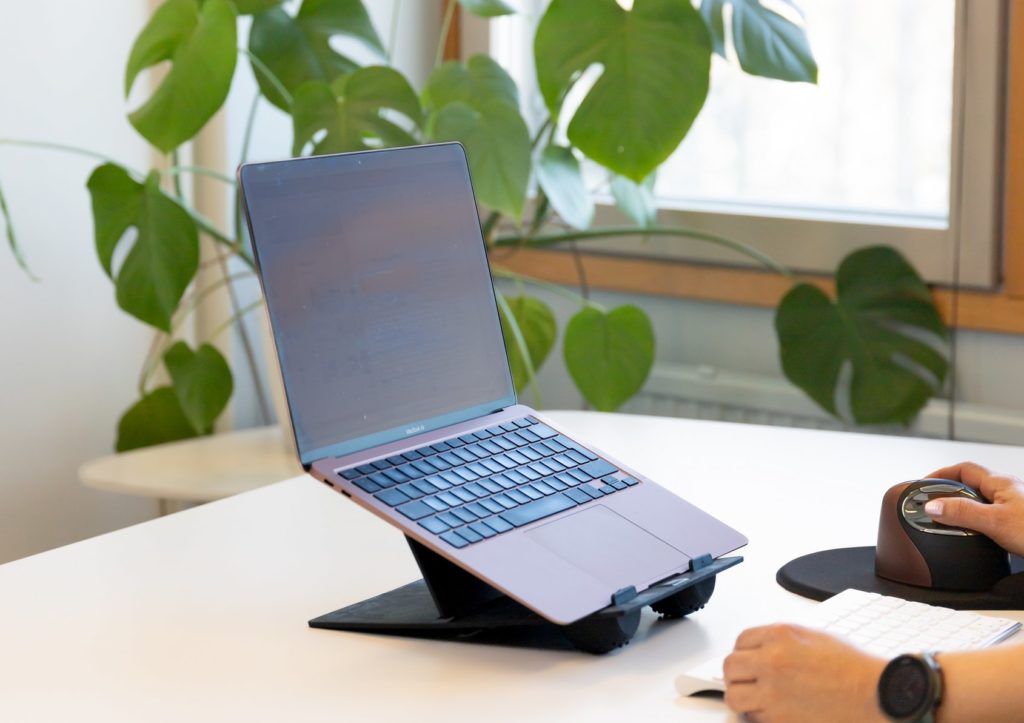When choosing an ergonomic laptop stand, look for height adjustability to position your screen at eye level, sturdy materials that provide stability during typing, and portability features if you work from multiple locations. The ideal stand should have a wide range of height settings, allow for angle adjustments, support your specific laptop size, and integrate well with external keyboards and mice. These features work together to promote proper posture, reduce neck strain, and create a more comfortable and productive workspace.
Why is proper laptop positioning important for your health?
Proper laptop positioning is vital because looking down at a screen forces your neck into an unnatural bend, causing what experts call “tech neck” – a condition that leads to neck pain, shoulder tension, and headaches over time. The typical laptop setup creates a conflict: the screen is too low when the keyboard is at a comfortable typing height.
This awkward positioning doesn’t just affect your neck. When hunching to see your screen, your entire spine curves, leading to poor posture and potential back problems. Additionally, improper screen height strains your eyes as they work harder to focus, potentially causing eye fatigue and dryness.
An ergonomic laptop stand resolves these issues by elevating your screen to eye level. This simple adjustment helps you:
- Maintain a neutral neck position
- Keep your spine properly aligned
- Reduce eye strain by positioning the screen at the optimal viewing distance
- Create space for better air circulation around your laptop, preventing overheating
When your body is properly aligned, you’ll likely notice improved comfort during long work sessions and fewer aches at the end of your day.
What height adjustability features should you consider?
The most important height adjustability feature in a laptop stand is the ability to position your screen so the top edge is at or slightly below eye level. This creates the optimal viewing angle that maintains natural neck alignment and reduces strain during extended use.
Look for stands with multiple height settings rather than fixed positions. Your ideal height might vary depending on your chair, desk, and even your posture throughout the day. A good range should allow adjustment between 15-25 cm from your desk surface, accommodating different sitting positions and user heights.
Consider how the height adjustment mechanism works. Some common types include:
- Step-based adjustments with preset heights
- Continuous adjustment sliders or knobs
- Hydraulic or gas-spring mechanisms for easy, on-the-fly changes
The best mechanism depends on how frequently you need to adjust your setup. If multiple people use the same workstation or you alternate between sitting and standing, look for quick-adjust features that don’t require disassembly.
Remember that proper ergonomics is about customisation to your unique body proportions—what works perfectly for someone else might not be right for you.
How do material and stability affect your work experience?
The materials used in a laptop stand directly impact both its stability and durability. A stand that wobbles or feels flimsy will undermine your productivity and potentially put your device at risk. The most common materials each offer different benefits:
- Aluminium: Lightweight yet sturdy, excellent heat dissipation, modern aesthetic, typically the most durable
- Plastic: More affordable, lightweight, variety of colours, but generally less durable
- Wood: Warm aesthetic, environmentally friendly options available, good stability, blends with natural décor
Stability features are equally important. Look for non-slip surfaces on both the bottom (where it contacts your desk) and the top (where your laptop sits). Silicon pads or rubber grips prevent sliding during typing and protect both your desk and laptop from scratches.
Consider the stand’s base design as well. Wider bases generally provide more stability but take up additional desk space. Z-shaped or triangular structures often offer the best balance between stability and space efficiency.
Check the weight capacity specifications to ensure the stand can comfortably support your laptop model. Heavier laptops (particularly 15-17 inch models) require sturdier construction to prevent sagging over time.
What portability features matter for hybrid work environments?
For those who work across multiple locations, portability features become essential considerations when selecting a laptop stand. The most useful portable designs include foldable structures that collapse into a flat, compact form for easy transport and storage.
Weight is a critical factor—you’re unlikely to carry a heavy stand regularly, no matter how effective it might be. Aim for models under 300 grams if you’ll be commuting daily. However, avoid sacrificing too much stability for lightness; ultra-lightweight stands might wobble during typing.
Consider these practical portability features:
- Quick setup and breakdown (ideally requiring no tools)
- Included carrying case or sleeve
- Durable construction that withstands frequent handling
- Compact folded dimensions that fit easily in laptop bags
The best portable stands find the balance between minimalist design and functional stability. Some cleverly engineered models achieve remarkable rigidity despite their lightweight construction, using strategic angles and load distribution to remain stable under your typing pressure.
How can a laptop stand integrate with your broader workspace setup?
An ergonomic laptop stand should seamlessly integrate with your overall workspace design to create a cohesive, functional environment. Since raising your laptop screen necessitates using an external keyboard and mouse, look for stands that create sufficient space beneath the laptop or at the sides for these peripherals.
Cable management features are often overlooked but extremely valuable. Stands with built-in cable organizers prevent cord tangles and keep your workspace tidy. Some models include USB ports or pass-through cable slots to simplify your setup.
Consider compatibility with different laptop sizes. If you upgrade your device or share your workspace, an adjustable-width stand provides flexibility. Most quality stands accommodate laptops from 11-17 inches, but always verify the specifications match your current and potential future devices.
Think about how the stand works alongside other ergonomic equipment:
- Height compatibility with adjustable desks
- Space needed for ergonomic keyboard trays
- Coordination with monitor arms for dual-screen setups
- Integration with desk organisers and workspace accessories
The goal is creating a harmonious system where each component contributes to proper positioning and comfort throughout your workday.
What are the key takeaways for choosing the right ergonomic laptop stand?
When selecting an ergonomic laptop stand, prioritize height adjustability that positions your screen at eye level, sturdy materials that provide stability during use, and—if you work from multiple locations—portability features that make transport practical.
Remember that the perfect stand creates a comfortable viewing angle while maintaining enough space for external peripherals. Consider how it fits your specific work style, whether you’re primarily stationary or frequently on the move.
The right choice should address these essential factors:
- Promotes proper neck and spine alignment
- Offers adjustability to match your body proportions
- Provides stability that inspires confidence during use
- Integrates smoothly with your broader workspace setup
- Includes features relevant to your specific work patterns
At Gymba, we understand that ergonomic solutions need to fit naturally into your daily routine. Our laptop stand is designed with these principles in mind—light enough to carry anywhere yet stable enough for all-day typing. We believe that good ergonomics shouldn’t be complicated but should simply support your body’s natural alignment while you focus on what matters most: your work.
By investing in a quality laptop stand, you’re making a practical decision that supports both your immediate comfort and long-term health as you navigate today’s digital workspace.

